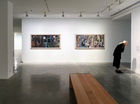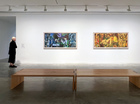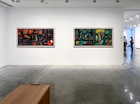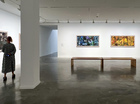COMMUNITY OF THE PEOPLE
Community of the People / black white
From that far away planetary place, that ancient past.
Out of that ancestral greyscale slurry
There lay a parental cradle that bred a colour spectrum
That kept its distance, but that distance was too far.
The dark, the light
The black, the white
The near origin of you
Community of the People / blue yellow
From that dark on dark and light on light
The unseeable to you
Evolved a worldly comprehension outlined by the colouring of material
A through and through of object and colour
Ruby a stone, ruby a colour
The blue, the yellow
The primary stain of you
Community of the People / green red
Colour generated the non-materiality of you
The very elevation of you
Another state of you
The co-ordinated form that lives as clone
On the otherness and brink of you
The symbols assigned by you
The green, the red
The very power and peace of you
—Diena Georgetti
Artist text
by Serena Bentley
Diena Georgetti paints herself into being. Her practice embodies her desire for a ‘bigger life.' (1) Mining the archives of her artist predecessors she adopts and remixes their sensibilities, casting herself as an artist of indeterminate time, gender and even profession. In fact, Georgetti is more inclined to refer to herself as a visual editor or curator as opposed to a painter, despite having an artistic practice spanning thirty years and counting.
Georgetti’s intuitive process involves a deep dive (often online) into the work of others, though direct quotations are rarely discernible. Spanning the worlds of art, architecture, fashion, and design, the images she recovers are combined and translated into scaled-up digital collages from which she paints her new compositions. This collage phase often occurs in one go, encouraging interweaving rhythms between the resulting works. Such is the case with her latest body of work for The National 4.
Previously, Georgetti’s strategy has been to assemble imagery according to contrast – pairing graphic with abstract elements, for example. In this new work, however, Georgetti’s compositional formula is one of painterly ‘sameness’; an effect enhanced by her almost monochromatic palettes, yet surprisingly not realised exclusively with a brush. In a further effort to remove her own hand, the artist also employs tools like cardboard, toothbrushes, templates, and potato prints to achieve her desired effects. Additional stylistic embellishments come in the form of the bespoke hemp and metal frames in which the works are placed. The overall effect is one of déjà-vu. Georgetti’s paintings often seem vaguely familiar, but it can be difficult to determine why.
The artist’s recombinations are instinctual. She holds little regard for the art-historical canon and the ‘names’ within it. Rather, her method of engagement is deeply personal, and simply reflects her interests at any given time. She is drawn to what an artist has made and why: the idea. For Georgetti, the art is in the edit. Her editing process is so strict that it has even involved the destruction of works the artist deems unfit. Their success lies in their behaviour in the domestic sphere, with Georgetti bringing works into her home and observing them as she goes about her everyday life – perhaps caught in reflections or amongst her furnishings. Observing this process, Georgetti stated:
If you catch it unguarded, and you like it, it’s good. It’s a good painting . . . If I am forced to cry in that time and the painting comforts me, it has passed and will survive. If it fails to comfort, it mocks, and will be destroyed. (2)
Georgetti sees art as ‘a unique archive that exists outside of language.' (3) She is a time traveller who upholds art as a sacred document that charts humanity’s remarkable evolution. She is also a humanist, and hers is a practice of reverence: honouring communities past and present and connecting contemporary art, art history, and the human experience.
(1) Artist in phone conversation with the author, 18 October 2022.
(2) Diena Georgetti, ‘The Civilization of the Abstract’ and ‘The Humanity of Abstract Painting’,originally published in Linda Michael (ed.), 21st Century Modern: 2006 Adelaide Biennial of Australian Art, exhibition catalogue, Art Gallery of South Australia, Adelaide, 2006, p.32; republished in Max Delany and Robert Leonard, Diena Georgetti: The Humanity of Abstract Painting 1988–2008, exhibition catalogue, Monash University Museum of Art, Melbourne, 2008, pp.34,50.
(3) Artist in phone conversation with the author, op.cit.
visit The National 4 on MCA website















